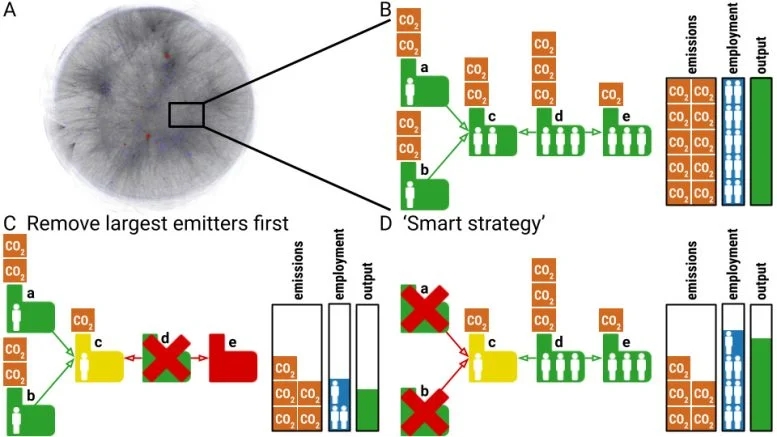博文
新的成本效益计划可以减少20%的二氧化碳排放,然而,它仍然需要花费数十亿美元
||
新的成本效益计划可以减少20%的二氧化碳排放,然而,它仍然需要花费数十亿美元
诸平
据奥地利维也纳复杂性科学中心(Complexity Science Hub Vienna, Vienna, Austria)2024年6月5日提供的消息,该中心最近的一项研究探讨了在对经济影响最小的情况下实施气候政策的策略。根据政府间气候变化专门委员会(Intergovernmental Panel on Climate Change简称IPCC)的说法,为了防止灾难性的气候变化,需要迅速而影响深远的变化(“rapid and far-reaching change”)。 新的“成本效益”计划可以减少20%的二氧化碳排放,然而,它仍然需要花费数十亿美元(New “Cost-Effective” Plan Could Reduce CO2 Emissions by 20% – However, It Still Costs Billions of Dollars)。
复杂性科学中心(Complexity Science Hub简称CSH)的约翰内斯·斯坦格尔(Johannes Stangl)解释说:“经济向气候中和的转变总是会带来一定的经济压力,一些行业和工作岗位会消失,而另一些行业和工作岗位会被创造出来。”在气候政策措施方面,如何将经济损失降到最低值得考虑。
一个CSH团队开发了一种新方法来帮助解决这个问题。“要想了解气候政策对一国经济的影响,光有二氧化碳的排放数据是不够的,我们还必须理解企业在经济中所扮演的角色。”2024年4月15日发表在《自然可持续发展》(Nature Sustainability)杂志网站上的研究报告的第一作者约翰内斯·斯坦格尔说。相关论文详见:Johannes Stangl, András Borsos, Christian Diem, Tobias Reisch, Stefan Thurner. Firm-level supply chains to minimize unemployment and economic losses in rapid decarbonization scenarios. Nature Sustainability, 2024, 7: 581–589. DOI: 10.1038/s41893-024-01321-x. Published: 15 April 2024. https://www.nature.com/articles/s41893-024-01321-x
参与此项研究的除了来自奥地利维也纳复杂性科学中心的研究人员之外,还有来自匈牙利国家银行(National Bank of Hungary, Budapest, Hungary)、奥地利维也纳医科大学(Medical University of Vienna, Vienna, Austria)、美国圣达菲研究所(Santa Fe Institute, Santa Fe, NM, USA)以及奥地利供应链情报研究所(Supply Chain Intelligence Institute Austria, Vienna, Austria)的研究人员。
二氧化碳排放量减少20%(CO2 emissions reduced by 20%)
研究人员使用了匈牙利的一组数据,其中包括近25万家公司和100多万家供应商关系,几乎代表了整个匈牙利经济。他们研究了一个国家的整个经济会是什么样子,如果某些公司在不同的情况下被迫停止生产,所有这些都是为了减少20%的温室气体排放。
CSH的斯蒂芬·图尔纳(Stefan Thurner)解释说:“在第一种情况下,我们研究了如果只考虑二氧化碳排放会发生什么。”为了减少20%的温室气体排放,该国最大的7家排放企业必须停止运营。然而,“与此同时,大约29%的工作岗位和32%的国家经济产出将会消失。这个想法完全不现实; ” 斯蒂芬·图尔纳说,“没有政治家会尝试这样的事情。”此外,如果考虑到温室气体排放和企业规模,将会产生严重的经济后果。
双因素法(A two-factor approach)
约翰内斯·斯坦格尔解释说,“有两个因素至关重要:一家公司的二氧化碳排放量,以及与之相关的系统性风险,即该公司在供应网络中扮演的角色。”CSH的研究人员在早期的研究中开发了经济系统性风险指数(Economic Systemic Risk Index简称ESRI)。它估计了如果一家公司停产将造成的经济损失。
考虑到公司的温室气体排放量及其对国家经济的风险指数,研究人员计算出了排放量大的公司相对于其经济影响的新排名。根据新的排名,二氧化碳排放量减少20%将要求名单上排名前23位的公司停止运营。然而,这只会导致2%的就业机会和2%的经济产出的损失。
在公司层面(At the company level)
“在现实中,公司自然会试图寻找新的供应商和客户。我们希望在我们模型的进一步开发版本中考虑到这方面,以便获得更全面的绿色转型图景。”然而,该研究的作者说,“我们的研究清楚地表明,如果我们想评估一项特定的气候政策将取得什么成果,我们需要考虑公司层面的供应网络。”他们表示,这是评估哪些公司将受到特定措施影响,以及这将如何影响其贸易伙伴的唯一途径。
在奥地利,公司层面的数据在很大程度上是缺乏的。风险评估通常在部门层面进行,例如,评估一项措施对整个汽车或旅游业的影响程度。
“与匈牙利、西班牙或比利时等其他国家相比,这使我们处于劣势,在这些国家,可以获得公司层面的详细数据。”斯蒂芬·图尔纳解释说,“在这些国家,增值税不是累积记录的,而是以标准化的方式记录所有企业对企业的交易,这意味着在该国的供应网络上可以获得广泛的信息。”
这项工作得到了奥地利联邦气候行动、环境、能源、移动、创新和技术部(Austrian Federal Ministry for Climate Action, Environment, Energy, Mobility, Innovation and Technology as part of the funding project GZ 2021-0.664.668)、奥地利科学基金(Austrian Science Fund FWF under P 33751)、奥地利科学促进机构{ Austrian Science Promotion Agency / Österreichische Forschungsförderungsgesellschaft (FFG) project under 39071248}以及奥地利国家银行{Öesterreichische Nationalbank(OeNB)Hochschuljubiläumsfund P18696}的支持或资助。
上述介绍,仅供参考。欲了解更多信息,敬请注意浏览原文或者相关报道。
Urgently needed carbon emissions reductions might lead to strict command-and-control decarbonization strategies with potentially negative economic consequences. Analysing the entire firm-level production network of a European economy, we have explored how the worst outcomes of such approaches can be avoided. We compared the systemic relevance of every firm in Hungary with its annual CO2 emissions to identify optimal emission-reducing strategies with a minimum of additional unemployment and economic losses. Setting specific reduction targets, we studied various decarbonization scenarios and quantified their economic consequences. We determined that for an emissions reduction of 20%, the most effective strategy leads to losses of about 2% of jobs and 2% of economic output. In contrast, a naive scenario targeting the largest emitters first results in 28% job losses and 33% output reduction for the same target. This demonstrates that it is possible to use firm-level production networks to design highly effective decarbonization strategies that practically preserve employment and economic output.
https://wap.sciencenet.cn/blog-212210-1437179.html
上一篇:全球开创性研究发现21种新型激光材料
下一篇:高血压患者如何保持认知能力和降低痴呆风险

